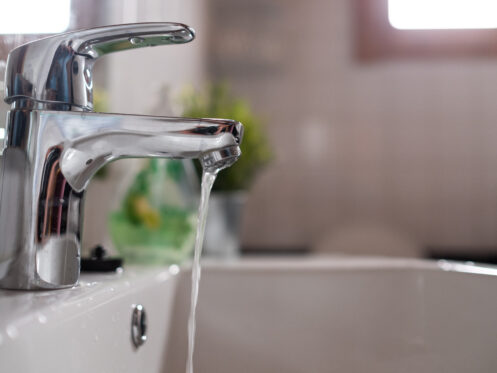One of the most important systems in your entire home is your plumbing system. It helps to provide you with fresh clean water so that you can do things like bathe, drink, and even clean. Unfortunately, if you’re experiencing low water pressure at your home, it could be due to a number of different issues. We’ll dive into what some of these issues are below so that you can help determine what the source of your low water pressure issue likely is.
What Is Normal Water Pressure for CA Homes?
Typical residential water pressure ranges between 40 and 60 psi (pounds per square inch). Anything significantly below this range can affect appliance efficiency, water heater performance, and overall comfort.
California’s unique water systems and conservation measures make maintaining consistent pressure a little more complex. Municipal water restrictions, drought conditions, and aging city pipelines can all influence flow rates to homes.
Local geography also plays a role. Homes in hillside neighborhoods or desert communities, such as Palm Springs or the Los Angeles foothills, often experience lower pressure naturally due to elevation differences and long-distance water delivery systems.
What Causes Low Water Pressure?
Low water pressure can come from something as simple as a clogged faucet screen or as serious as a leak under your home’s slab. Common culprits include:
City Water Problem
One of the most obvious reasons that you may have low water pressure at your home is that there’s a problem with the city’s water supply. If there was a water main break, it can significantly reduce the amount of water coming into your home. For this reason, the first thing you always want to do when you experience low water pressure is contact a neighbor or check your city water company’s website. This would allow you to determine if there’s a problem with the main city supply line. Unfortunately, if there is, there’s nothing you can do about it. You’ll just have to simply wait until they repair the issue for you.
Clogged Aerator
Another important step to take is to check other fixtures in your home. You want to determine whether the problem is with that individual fixture or your entire home. If the problem of low water pressure only happens at the fixture, it’s a key indication that it likely has an internal problem. In many cases, the aerator for your faucet or shower head may simply be blocked with debris and need to be cleaned. The aerator is a mesh-like piece that sits close to the end of the faucet or shower head to help reduce splashing by mixing air with the water.
Water Leak
One really unfortunate reason that you may have little water pressure is that you have a leak somewhere in your water supply line before that fixture. With some of the water pouring out of the leak, less water is left to travel to your faucet. It can be a good idea to examine fixtures on that water line that run before the one you’re trying to use to help narrow down where the problem may be.
If you suspect that you have a water leak, it can be helpful to shut off your water supply line and contact one of our plumbing professionals for leak detection service. You never want to let a water leak go as it can lead to a lot of damage in a very short amount of time.
Mineral Buildup
Another reason that you may have poor water pressure inside of your home is that there is excess sediment buildup inside your piping. This is very common if you have hard water in your home that isn’t treated with a water softener system. Over time, the excess magnesium and calcium will start to adhere to the inside of your piping material. This can cause a partial restriction in the flow of water through the line.
This will typically come on over a lengthy period of time, as you’ll notice that your water pressure seems to be getting lower and lower. In some cases, one of our plumbers can flush the line to remove the partial restriction. In other cases of excessive mineral buildup, we may have to replace that section of water line.
Interior Pipe Corrosion
Another problem that hard water can cause for your plumbing system is corrosion on the inside of your piping. Just as sediment buildup can restrict water flow going through the line, so can an excessive amount of internal corrosion. The issue with internal corrosion will happen over a long period of time as your water pressure slowly decreases. The only fix for this type of issue is to replace the sections of water line that have internal corrosion.
Partially Closed Water Valve
One of the more obvious reasons that you may have low water pressure is that one of your water supply valves is partially closed. It’s vital that your main water supply line be open completely to allow as much water as possible into your home. If that valve got accidentally knocked, your low water pressure could simply be due to the fact that there’s not enough water coming into your home to start with.
The same holds true for any of the valves on your water supply lines. These include valves, like underneath your sinks and vanities that may have been partially closed by accident. Fortunately, this problem has a very easy fix. All you have to do is open the valve the entire way to allow as much water as possible through the line.
Corroded Water Heater
Just as hard water can impact your water supply lines, it can also impact your hot water heater. Hard water tends to prematurely deteriorate the internal components of your water heater and lead to malfunctions. Over time, a buildup of sediments in your water heater near the outlet valve can cause a restriction in the flow of water out of your water heater.
You can verify that this may be the issue by checking both the cold water and hot water at your faucet. This will allow you to see if the low water pressure issue only happens when you’re using hot water. In some cases, the water heater can be flushed to remove the partial clog while in others it may need a complete replacement due to excessive internal tank corrosion.
Faulty Pressure Regulator
Almost all homes throughout the nation are required to have some sort of pressure regulator that helps to control the water pressure coming through the pipes in their home. This regulator gets placed near the main water supply valve so that it can start controlling the pressure of all the water that comes into your home. Unfortunately, if the pressure regulator is malfunctioning, it could be restricting the flow of water in your home significantly. If you believe that you have a pressure regulator problem, it’s best to call our plumbing professionals to get assistance.
Too High of Water Demand
Another common reason that you may be experiencing low water pressure in your home is that you’re using too many appliances and fixtures at once. While typical households should have no problem running a couple of faucets at the same time without losing water pressure, it isn’t uncommon to experience a drop in water pressure. This could occur if you’re trying to run multiple faucets, your dishwasher, and your clothes washer all at once. You may need to stagger your water usage throughout the day to help ensure that you maintain adequate pressure at all different points.
Localized vs. Whole-Home vs. Municipal Water Pressure Issues
Determining whether the problem is limited to one fixture or your entire system helps narrow down the cause.
- Localized issue: A single slow faucet or showerhead usually points to debris buildup or a faulty fixture.
- Whole-home issue: Low pressure everywhere often indicates a main line problem, regulator issue, or internal pipe corrosion.
- Municipal issue: If neighbors also experience weak pressure, the problem likely originates from the city’s water supply.
Regional Factors That Affect Water Pressure in California
- Drought and water restrictions: Water agencies may reduce pressure to conserve resources.
- Aging infrastructure: Many California cities rely on decades-old water mains that lose efficiency due to corrosion and leaks.
- Hard water regions: Communities like Palm Springs, Bakersfield, and Fresno are known for heavy mineral content that accelerates pipe scaling.
- Elevation changes: Homes on steep hillsides naturally experience reduced pressure due to gravitational drop.
How to Troubleshoot Low Water Pressure at Home
Before calling a plumber, homeowners can try a few basic checks:
- Test all faucets to see if the issue is isolated or system-wide.
- Remove and clean faucet aerators and showerheads.
- Confirm that all shut-off valves are fully open.
- Check your pressure regulator if it’s accessible.
- Ask neighbors if they’re experiencing the same problem.
If pressure remains low after these steps, it’s time to call a professional.
When to Call a Professional Plumber for Water Pressure Issues
Professional help is essential if:
- Pressure drops suddenly.
- You hear banging pipes, notice rust-colored water, or suspect a slab leak.
- DIY fixes don’t solve the issue.
A licensed plumber can:
- Measure pressure at multiple points.
- Inspect for corrosion, hidden leaks, or PRV malfunctions.
- Recommend pipe replacements or filtration systems to prevent future buildup.
How to Prevent Water Pressure Problems
Routine maintenance keeps your system strong and efficient:
- Schedule annual plumbing inspections to detect corrosion or leaks early.
- Flush water heaters yearly to remove sediment.
- Install a water softener or filtration system to minimize scaling.
- Maintain your pressure regulator and replace it as needed.
- Insulate outdoor pipes to reduce stress from temperature swings.
- Fix small leaks before they become major pressure losses.
Costs & Long-Term Value of Fixing Low Water Pressure
Addressing water pressure issues early is far more affordable than emergency repairs. Regular maintenance not only preserves water flow but also protects your plumbing investment, keeping your California home efficient, reliable, and ready for the long haul.
- Cleaning fixtures yourself: $0 to $50
- Replacing valves or regulators: $150 to $400
- Whole-home repiping: $3,000 to $10,000, depending on type and amount of material
Expert Plumbing Repair Service
General Air Conditioning & Plumbing offers expert plumbing repair service to the Thousand Palms, CA community. We can also help with all your plumbing installation, toilet service, leak repair, water heater, water service, and faucet repair needs. Simply call us today to schedule your next service consultation.


